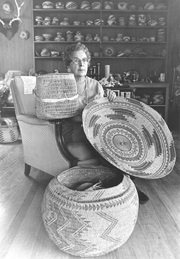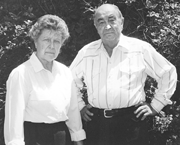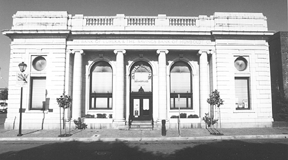

by Rosemary Edmiston

The late Elsie Hover with some of the family's basket collection that now belongs to the Clarke Museum in Eureka. (Photo courtesy of the Hover family)
IN THE EARLY 1980s, Lee Hover became somewhat of a local celebrity after donating a good portion of his family's American Indian basket collection to the Clarke Memorial Museum in Eureka. He and his wife Helen nearly filled a photo album with clippings from the many publications that wrote about the 179-piece assemblage. More than one museum newsletter carried Lee Hover's picture and story.
"The more I get into this, the better I feel about it," he said of the basket sale and donation in the book The Hover Collection of Karuk Baskets published by the Clarke in 1985. "People have actually stopped me on the street to say how much they appreciate it that the collection is at the museum. This collection is a living memorial to the Karuk basketmakers. We feel confident now that it will be preserved for everyone to enjoy."
But 15 years later the Hover's relationship with the museum has so deteriorated that the president of the nonprofit institution's board of directors felt compelled to summon a Eureka police officer on March 25 when he learned the Hovers had been allowed into a restricted area to view stored baskets.
Members of the board called the incident unfortunate. Critics say it stems, however, from deeper problems plaguing the 38-year-old museum, located in an historic Old Town building.
"Somebody's falling down on the job," Lee Hover says.
Some former museum employees and board members say difficulties with finances, management and deferred building maintenance stem from a board of trustees that refuses to accept change.
Others, however, say the Clarke's struggles are no different from small, nonprofit museums across the country.
"I think the place has great potential," said former curator Ray Hillman. "But it's going to take money and take a board that can make decisions and stick with them and stop back-tracking."
Former curator Coleen Kelley Marks, who helped acquire the Hover collection but was fired in 1985, said, "Unless they get some serious funding they're going to close. They cannot keep going on limited funding."
Some board members say criticism of the Clarke is not rooted in fact and is being generated by disgruntled former employees.
"The museum is not in any kind of difficulty. It's a figment of someone's imagination," said Fred Slack, on the board since 1980 and now a trustee-for-life.
But newer board member Wendy Wahlund acknowledges that finances are stretched, and board president Grant Ferguson said the Clarke has money for day-to-day expenses but little else.

Helen and Lee Hover at home in Bayside (Photo by Brandi Easter)
The Hovers, along with a cousin from Oregon and her two school-age children, were in a restricted security area at the museum cataloging stored baskets when Ferguson arrived and asked them to leave. When the family would not (they had permission from other board members), Ferguson called the police. He did so, he said, because non-employees are not allowed in the sensitive security area.
"They really didn't know where these things were or what they were seeing," Ferguson said. "And the idea that we were missing 30 baskets or 40 baskets was ridiculous. Yet we were accused of this and we were accused of preparing one of them for sale.
"For that very reason no one is allowed in that area except museum personnel. It's like money in the safe in the bank sort of thing. You don't take visitors with you to see it."
The family did complain that baskets were missing (although they were later located), and that some were poorly kept.
But nothing was missing, said Rosemary Hunter, a newly appointed life trustee and the museum's volunteer basket curator. Hunter, who was out of town at the time of the Hover's visit, said had she been present there would be no misunderstanding.
"All of this could have been avoided if (former curator) Claudia Israel had only called and asked me to come in, prepare for your visit and be on hand to answer questions," she wrote in a letter to Karen Young-Lenk, who visited the North Coast from Oregon specifically to see the basket collection.
Israel set up an appointment with Young-Lenk two months prior, but was no longer working for the museum at the time of her visit. Israel said she, too, was dismissed by the board (in late March) and not given a reason.
"We had some storage problems," Ferguson acknowledged, "and we moved things around. So maybe they weren't all in exactly the same place that they expected."
Ferguson also said the museum has had a greater rate of employee turnover recently. "We had internal problems. We're trying to correct them like any other institution," he said.
The system of appointing five of the 15 board members as lifetime trustees, some people say, is at the core of the controversy.
"We tend to have an older board," Wahlund said, but that does not mean there is resistance to change. "I've never felt a clash of old and new."
Opened by the late Eureka High history teacher Cecile Clarke in 1960, the museum was originally run by a traditional board, in which directors must be re-elected, until it was decided a group of dedicated volunteers should be appointed trustees for life. Non-trustees may serve up to six consecutive years before the bylaws require a one-year break. They may or may not be asked to return to the board.
Funding for the museum comes from earnings from a trust fund established by Cecile Clarke, as well as a $10,000 annual grant from the city of Eureka, member dues, donations and stock earnings. The Clarke closed 1997 with $222,000 in assets, according to tax documents. The board spent nearly $86,000 that same year, ending with a surplus of $16,500.
"I don't think they're going to stay afloat. I really don't," Lee Hover said.
That, says Ferguson, couldn't be further from the truth.
But the museum currently does not have the staff to rotate the Hover collection to the family's liking, is without a curator and is short on docents. Board members and trustees including basket curator Hunter have been filling in.

The Clarke Memorial Museum in Eureka. (Photo by Brandi Easter)
Wahlund said, "If the Clarke wasn't in such a financial situation" an Indian artifact curator would be hired.
"I think the energy isn't there to pursue fund-raising activities," she acknowledged. "The museum fully realizes that we need to bring in some more funds."
The museum does plan to hire a curator to oversee the entire operation, which also includes Victorian, maritime and logging exhibits, among others, Ferguson said.
The Hover collection went on display in May 1985, culminating two years of fund-raising efforts by the community. The collection of baskets and dance regalia was appraised at $96,000. The Hovers, who divide their time between Bayside and Willow Creek, donated one-third of the value. The museum raised the rest, with large grants from the Pacific Lumber Co. and the Humboldt Area Foundation.
Ten years later the Hovers sold a second collection to the Clarke, made up of all their remaining baskets and artifacts. For Lee Hover, parting with the final pieces of the collection was difficult, but he said he had a strong desire to keep it intact.
The collection, predominantly 19th century, was started in 1850 by John and Emma Pearch of Orleans, Lee Hover's great grandparents, and passed down through the generations, finally to Lee.
In the book The Hover Collection of Karuk Baskets, historian Pam Mendelsohn writes: "When Lee's mother died in 1972, he was quite concerned about what to do with the collection that was now his. The collection was put into storage for two years, and then Hover decided to lend a portion of it to Humboldt State University for 10 years, since his mother was an alumna."
When the Hovers decided the collection should be in a museum they had serious discussions with the Smithsonian Institution and private collectors, but ended up deciding upon the Clarke so that the collection would remain local and be on display. The Smithsonian, they were told, would put a large portion in storage.
It was agreed the collection would be a permanent exhibit. The Hovers say the Clarke has violated that promise, displaying only a tiny portion of the artifacts. Museum officials disagree.
The discrepancy lies, in part, in the interpretation of the contract. It has been fueled by misunderstanding and lack of communication.
"They forgot they're supposed to show at least one third of (the baskets) and they're supposed to be making an effort to get the rest of them out on display," said Lee, who is one eighth Karuk. "I brought this to their attention and I was always told we're working on it, we don't have the money right now."
In a March letter to the museum, Young-Lenk, wrote: "Mr. Hover, as he has done for the past year, expressed his concern that the collection is not being displayed adequately. Today there is about one-fifth of the 203-piece collection on display and some items have seldom if ever been displayed in the 15 years the Clarke Museum has had the collection."
Museum officials contend the Clarke does not have the room for a larger display, and that it is bad practice to leave artifacts out in flourescent light for too long.
Hunter, the volunteer curator, has been credited by her colleagues for meticulously caring for the baskets and artifacts. The baskets, she said, "are being stored properly. They're being kept on shelves with acid-free paper and with a dark covering to protect them from light."
To preserve the baskets, it is also imperative that they be given "rests" in storage, Hunter said. Karen Holmes, curator of the Grace Hudson Museum in Ukiah, agreed. The Hudson is hosting a national exhibit of Pomo Indian baskets.
According to Holmes, baskets should only be on display six months at a time. Temperature, humidity and handling are also important.
The temperature in the Clarke does fluctuate, but the handling and care otherwise meets standard museum practices, according to those associated with the Clarke. But the building also has mold and humidity problems.
Since he was escorted from the Clarke by police, Lee Hover has been invited back to the museum by Ferguson for a one-time private viewing of the stored baskets.
Board member Wahlund believes a solution to the problem might be establishing an advisory committee for the basket collection.
"I'd like to see Lee (Hover) involved," she said. "He's always wanted to be involved in the museum. That's not for me to decide. That's for me to suggest."
"This is not insurmountable," Ferguson said. "If they'll come in and tell us exactly what they want other than display the whole thing out there we'll be happy to listen."
The North Coast Journal Table of Contents